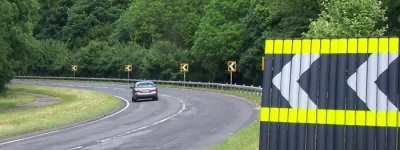As public opposition to London's urban motorways grew, the London Motorway Action Group (LMAG) and the London Amenity and Transport Association (LATA) both agreed that Ringway 3 should still be built, approving of an outer ring road to keep through traffic away from the city. But not all of Ringway 3 would be as straightforward as it first seemed.
It turned out to be a ring of two distinct halves. In the north and east, it ran almost entirely through open country, and progress was easy. Parts began to open to traffic from 1975 onwards. In the south and west, though, a distance of 10-14 miles from the centre put the motorway through plenty of well-established suburbia. In north west London, no agreement could be reached on where the road should go, and every government body with a stake in the road put forward their own suggestion. It's now virtually impossible to keep track of all the competing ideas. In the south, no line was even selected before the project was dropped.
1973 saw the cancellation of all the GLC's motorway plans, and the publication of the Layfield Report, which called for a single outer ring motorway. The idea was to build one ring from whichever components of Ringways 3 and 4 were easiest, with some minimal new road to link them up. Ringway 4's South Orbital Road was pretty much ready to go at that time, which avoided the need to battle through intractable problems in south and west London. It was connected to the north and east sides of Ringway 3, which were making steady progress towards completion already, to form the "London Outer Orbital Road". We now know this patchwork road by a different name. It's the M25.
What follows, then, is a history in two parts. The north and east sides of Ringway 3 will be familiar, tracing the history and the route of about half of the modern M25, though that doesn't mean there's nothing new to discover. The south and west sides are something else entirely: a tour of a whole range of urban motorway proposals, remarkably destructive and fearsomely difficult to build, and a story of long-running battles between government departments over where exactly London's third ring road should go - and even, at times, what it was for.
Picture credits
- Interchange plan extracted from MT 106/287.
- Extract of map showing M16 is from RAC England & Wales (1977), produced for the Royal Automobile Club by George Philip Group.
- Photograph of Bell Common Tunnel is from Department of Transport (1986). The M25 Orbital Motorway.
Sources
- LATA and LMAG supported construction of R3: Hart, D. (1976). Strategic Planning in London: The Rise and Fall of the Primary Road Network. London: Pergamon, p168.
- R3 located 10-14 miles from central London: HLG 159/1024.
- GLC describe R3 as outermost; purpose to serve long distance traffic: good example in (1969). This way to London: A summary of the Greater London Development Plan. London: GLC.
- R3 adapted from Abercrombie's "D" Ring: Buchanan, C. (1970). London road plans, 1900-1970. London: GLC, p45.
- Responsibility entirely with MOT; designated motorway Oct 1966: MT 106/413.
- Adapting advanced parts of R3 and R4 to form one ring: HLG 159/626.
- London Outer Orbital Road name: MT 120/314/1.
